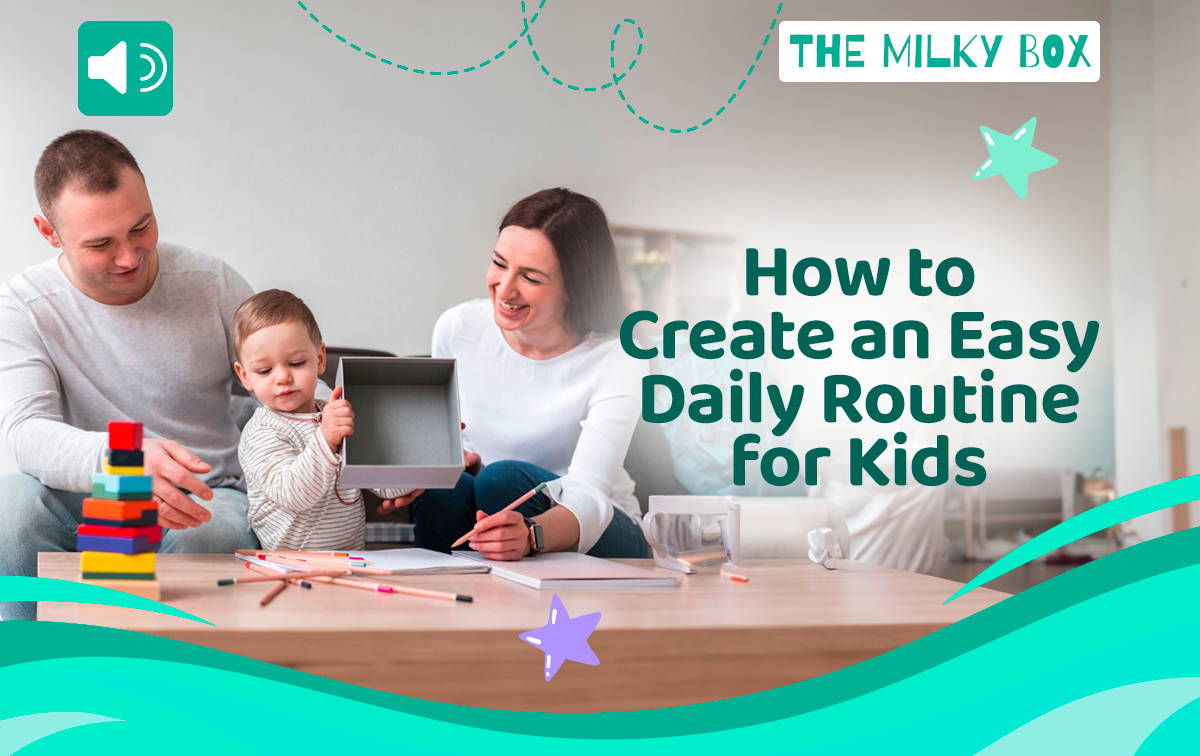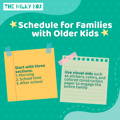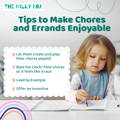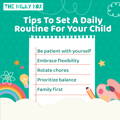Template routines are great. They include beautiful graphics and colors, and they offer the versatility of being edited with a few clicks. If something changes, you can just reaccess the document and adjust. They can also be themed according to the time of the year. Your little ones are going to love them.
How to Create an Easy Daily Routine for Kids: Step-by-Step Guide
By: Dr. Maria Cerino - Updated May 13, 2024 - 16 Minute Read

Routines in raising children are, without a doubt, crucial steps for healthy development. It’s a tool to plan family time; it enables closeness and feelings of safety in children’s environment. It manages their expectations and teaches them about the importance of discipline from early on.
You’ve heard about bedtime routines, feeding times, scheduled playtime, and more. It can be overwhelming, particularly when trying to fit a lot into a day, but there are ways to implement routine and get things sailing smoothly.
Having a daily plan is also a lifesaver for parents; it’s a way to regain some control over what many consider a chaotic stage in life.
In today’s article, we’re going to cover all about routines, from chores and errands to amazing tips on how to implement a routine gradually.
Parenting Changes
To implement change, we, as parents, need to evaluate our children’s needs, think about our responsibilities outside of parenting, and we need to make a list of all the daily tasks we’d like to accomplish to help things run smoothly.
There is no shame in taking a step back and realizing we’ve been going through the motions, letting things derail for some time. This is normal, this is expected for most parents, especially in multi-kid homes. It’s simply too much to handle.
There are other big factors that can cause instability: Divorce, separation, new family members, and moving. These all can throw their routine off, and we need to keep them in mind while designing a routine, trying our best to blend it in smoothly.
We have to embrace our challenges and lean on flexibility to get things back on track. In no time, you’ll have it all figured out.

Helps Children Imbibe Healthy Habits
For children, most things are routine. They base a lot of their daily actions on repetition and imitation, and it’s important to make the most of that to teach them about daily habits and set them up for smooth mornings as they grow and become independent. Once they reach six years of age, they start getting more and more ready to do things on their own.
Trusting your children with daily simple self-care tasks that they can accomplish on their own is perfect for developing their independence and confidence. These are called activities of daily living (or ADLs as they’re known in the therapy world.) It prepares them for the “real world.”
Some good examples of these activities are brushing hair, getting dressed, brushing teeth, and, for younger kids, putting their toys back in their baskets. Things at the beginning will not be easy; a lot of kids tend to throw tantrums and refusals, but slowly and surely, they will come around.
They will start cherishing those daily tasks once they embrace the idea of independence. You can start by implementing one every few months. For example, teaching them to brush their teeth might take a couple of months, as it requires motor skills and coordination, but surely they’ll get there.

Identify Tasks for the Day
To create a schedule that fits everyone, the first step is to enlist all the “fixed” commitments. School hours, bedtimes, work hours, dinnertime, meal prep time.
The idea is to write them down so you can easily visualize and sort them by priority to create suitable blocks of time. You can also identify problem areas regarding your children’s schedule: when is it harder for them to fall asleep? What times do they need support with their homework?
Having this info will be your savior when your routine falls off track, or you feel like you’re taking too much time for certain activities. It’s all about adjusting to your and your family’s needs.
Time-Based Schedules
Time-based schedules are amazing when we keep flexibility in mind. Some tasks have precise times: work ends at 5:00 pm, while others have much more wiggle room. For example, snack time can be moved one hour back when your little one is not hungry, or breakfast is hearty that morning.
Playtime can also be broken into small chunks instead of one large time block. It will all depend on each family’s style and occupation, but a good rule of thumb is to categorize them into “fixed” and “flexible” activities so your day goes without stress to stick to a strict schedule.
Create a Schedule
Once you’ve got all your tasks ready and time blocked, it’s time to write them down in the order that you expect them to be done during the day. Many people love dividing their schedule by colors by morning and afternoon. When it’s split up into blocks like these, it makes it less overwhelming. Some people love using lunchtime for this division.
For families with older kids, you can use three sections: morning, school time, and after school. You can go crazy with your schedule and use stickers, colors, and colored construction paper; the possibilities are endless.

Visual Schedules and Visual Timers
For kids, having visual stimuli is everything. It’s the key to why books with big pictures, colorful cartoons, and movies work best for them. They catch their attention and spark their curiosity, and let’s be honest: as adults, we love having reminders out in the open. It’s easier to follow, identify, and train the brain to follow a certain pattern.
You can also choose the exact amount of time to display: some families with older kids prefer a big whiteboard with a weekly schedule, perfect for penciling in all family activities as well as individual activities such as extracurricular activities. A daily schedule might be better for toddlers and smaller children who are just dipping their toes in the world of schedules. It’s simple, easy to follow, and less overwhelming.
Visual schedules are also great for making chores seem less cumbersome. They can get a sense of how much a task is supposed to be performed. For example, you can set a 15-minute window to pick up their room. They can focus solely on that task for those minutes and get things sorted out fast, leaving room for their favorite activities later.
A routine is all about developing habits. Ultimately, a productive day is just a sum of tiny actions that keep the house organized and the kids entertained and help us parents lower our stress. This is why putting your schedule in a place where everyone sees it is essential.
A good spot is the kitchen, the living room, or the landing up the stairs. These places have to be easily accessible and challenging to avoid. Eventually, the reminder will stick, but you must be patient, embrace flexibility, and manage everyone’s expectations.
While we’d all love it if everyone followed the schedule down to a T from day one, this will take weeks and a few adjustments to happen it’s the way our brains work. Don’t worry about getting there fast. Give yourself room to adjust, too.
How to Teach Your Kids the Routine and Set Expectations
Now, talking to your little ones about routine is the toughest part. It’s important to tailor the conversation and the schedule to your child’s age and developmental stage. School-aged children will need longer blocks of work time to deal with homework; they will ask for more social time with their pals. Meanwhile, younger children will benefit from longer playtime.
For younger toddlers and babies, you can implement the routine yourself and use verbal cues for them, such as breakfast time! bath time! This will signal to them that these activities require an order and are done at certain times of the day.
It Helps Manage Screen Time
If you, like many parents out there, are worried about screen time, a schedule might be just what you need. Excessive screen time can negatively impact physical health, social skills, creativity, and overall well-being despite technology’s numerous benefits.
When building a schedule, remember that trying to take all screens away at once from your kids may not have a good ending. It can hurt their feelings and bring out distrust and loss of control.
Instead, opening up spaces in the daily schedule for iPad time or TV time can satisfy their curiosity for their favorite content while complying with safer time limits. Then you can get them involved in other activities such as outside time to keep them away from a high screen time.
Parents should lead by example and limit their time spent in front of the TV, on the computer, or using a smartphone or tablet. Family time should be scheduled as a priority over entertainment media.
Safely Moving Through the Environment
A lot of parents want to do their very best to enhance their little ones’ motor skills. That gives them a great push in life, as it increases their curiosity for the world out there.
By keeping screen time in check, you can utilize some of that time to help them develop these skills, here are two amazing ways on how to do it:
1. You can pencil in sometime during the day to help them develop these skills, for example, walking a pet. It’s a great way to practice their walk and get in touch with nature.
2. Designed tasks and chores must be tailored to their level of skill: Playing catch for visual perception or setting up obstacle courses during playtime to enhance their perception of their environment.
Working on these skills from a young age will help their development and prepare them for chores, sports, and other necessary life skills
Sitting Down for a Meal
At The Milky Box, we believe sharing meals as a family is crucial for their development. It should be a fun, positive experience for everyone involved. For many families, this becomes challenging, especially for households where both parents work or families of shift workers.
It doesn’t have to be a daily occurrence in these instances, but putting it on the weekly calendar is a great idea. You can make it exciting by ordering in, using fun tablecloths or plates, or making it a themed night such as “taco night”.
It’s a good idea to allow your child to control one aspect of a special dinner: they can pick colorful napkins or their favorite side. This will help them feel more like active participants and less like guests.
Another great tip that therapists swear by is introducing some activity before dinnertime. Letting them run around for a while, jumping on their bean bags. It prepares the body to sit down for a while and soothes the nervous system to identify dinnertime as a chill, calm day.
Chores Make Children Responsible
Now, let’s talk about chores: implementing them will be difficult at first, but it will implement a sense of responsibility that will become their driving force as adults. It’s healthy and helps parents feel a sense of ease and control over their child’s education. Picking age-appropriate chores is key for their development, and we’re here to help.
Examples of Age-Appropriate Chores
Younger children will not have the motor skills necessary for many chores, but starting small is important. As they age, you can move them up until they reach independence.
Here’s our chart of age-appropriate chores:
Ages 2-3: Tidying up toys in a basket, putting away dirty clothes in the hamper
Ages 3-5: Feeding pets with supervision, helping make the bed, putting clean clothes away
Elementary (6-12): Helping with dinner prep, sorting clean clothes, watering plants, wiping surfaces, putting clothes in the washer (you can help them program it and measure out detergent)
Teens: Taking out garbage, washing and drying their clothes, cooking, washing dishes, cleaning their room
Tips to Make Chores and Errands Enjoyable for Kids
There are many ways to motivate them to complete their chores, and it’s going to depend a lot on their age, but our top tips are:
● Let them create and play their chores playlist
● Beat the clock! Time chores so it feels like a race
● Start by doing the chores with them, dance around and lead them by example
● Offer an incentive: ice cream, watching a movie together, a few dollars extra for their allowance

Making a Child's Bedtime Easy
Let’s talk about bedtimes. They’re one of the hardest routines to master. Perhaps the day’s exhaustion sets in and makes these steps look harder than they seem, but a good sleep routine is the foundation of a healthy life.
Children who sleep better and take less time falling asleep reap the benefits of routine and early bedtime years down the line. A study found that working memory and cognitive performance are improved compared to children who don’t follow a routine.
A proper bedtime routine should be started before they’re sleepy. It should start early and set the done for the rest of the time, signaling that the day has come to an end, and there will be more playtime later.
Typical bedtime activities include:
● Shower/bath
● Brushing teeth
● Using the bathroom
● Bedtime snack
● Preparing outfit/backpack for the next day
● Talking about their day
● Bedtime story
These routines can be adjusted according to your child’s age. But generally, we recommend using the bathroom to be the very last activity they do before lying in bed; this will help sleep come faster and prevent accidents in younger kids.
Every bedtime routine should end with a kiss and a good night. This will set the tone for the rest of the night and lead them into calm, warm sleep. Parents are recommended to leave the room before their child is asleep, but once they’re sleepy. This will help them learn to fall asleep on their own.
Tips To Set A Daily Routine for Your Child
Routines in children are about creating discipline, managing time, and bringing uniformity to your daily life. A routine will change with the seasons and different family dynamics, but our final five tips are:
1. Be patient with yourself: allow the routine to change, give yourself time to adapt and reinvent routine.
2. Embrace flexibility: Birthdays will come up, and family reunions. It’s okay to scrap the routine board for the day.
3. Rotate chores: For multi-children home, it’s good to rotate tasks between them, giving them a sense of fairness and control.
4. Prioritize balance: There’s no need to scrap screentime completely or force yourself to cook dinner when the day’s been crazy. Ordering in is fine occasionally; taking ten minutes off reading time is okay if your little one has a playdate.
5. Family first: Setting a schedule is a task that everyone should be involved in. Talk to your partner, let them know how important this is for the family, talk to your older kids, and get them on board.

What About a Feeding Schedule?
The American Association of Pediatrics strongly advises against introducing solid foods to babies before they reach the 6-month mark. Doing so could lead to a decrease in your breast milk supply, as your baby may breastfeed less.
Additionally, starting solids too early could result in a diet that lacks essential nutrients like protein and fat.
On the other hand, starting solids much later than six months is not advisable since it can cause eating problems. In some cases, there is a window of opportunity for children to learn how to eat solids, and if they miss it, they may require assistance from a speech or occupational therapist.
At this stage, your baby is likely consuming breast milk or formula six to eight times a day. By the age of one, the goal is to have them eating about six times a day a day:
● Breakfast
● Mid morning snack
● Lunch
● Mid afternoon snack
● Dinner
● Pre-bedtime snack
Parents usually start by feeding their babies with solids in the morning and gradually include them in the evening meal. However, you can choose to feed your baby at any time convenient.
When introducing solid foods, you should choose a specific mealtime. This will help your baby to expect this as part of their regular schedule and eventually become part of the family meal routine.
Follow-On Formulas
A good indicator of readiness is when they reach the age of six months and are ready for European Follow-On Formulas.
Stage 2 formula is specifically designed for babies over six months old. It contains the most essential nutrients in infant formula but with increased iron, vitamin D, and calcium levels.
These nutrients help support physical growth and strengthen bones and muscles, which is essential for babies as they develop their motor skills at this stage. You can help your little ones thrive and explore their fullest potential by providing them with the extra energy they need.

Creating the Best Routine for Your Family. In Conclusion…
Finding the perfect routine for your family can be daunting, but it's important to remember that the best routine caters to your family's unique needs. It's perfectly normal for routines to change occasionally, but it's essential to communicate these changes to your child. This way, they can prepare for what's to come and learn to be flexible in the face of unexpected changes.
Discover The Milky Box’s wealth of resources for a happy, healthy, and connected family. From expert nutrition advice to effective routines, we have resources to ensure your family thrives.
Frequently Asked Questions
Is a print-out routine good? Do I need to hand-make one?
How can I make my child sleep early? I have trouble putting them down at bedtime.
There are a few ways to help them out. One of the most important ones is to limit screen time after dinner. it’s best to allow them to go online in the mornings. Exposition to screens is harmful when it comes to melatonin release. You can also encourage physical activity, as much as possible, before dinner; this will help them tire out after their meal.
If screen time is allowed after dinner, consider keeping children at least 6 feet away from TVs and wearing blue blocker glasses. Also, put iPads and iPhones on ‘night watch/mode’ to remove the most visually disturbing colors.
How can I make mornings less stressful? My house is always a mess after they leave for school.
We get you. Mornings are chaotic at all ages, but prepping in advance is key. Some moms swear by packing lunches and water bottles the night before; this reduces lunch prep time. However, it’s essential to recognize that small kids, specifically, aren’t able to keep things in check as well as we do. Keeping a checklist and picking up as they go is an excellent way to avoid chaos during the mornings.
Is there a way to incorporate our nanny into the routine?
Absolutely. You can talk to them and show them your board; some people like creating printouts for their nannies. This helps them follow your instructions while you’re out, and it creates a sense of familiarity for your kids, as their routine isn’t disrupted when a parent can’t be there, particularly during bedtime.
Disclaimer:
Please be aware that this information is based on general trends in babies, and it is not medical advice. Your doctor should be your first source of information and advice when considering any changes to your child’s formula and when choosing your child’s formula. Always consult your pediatrician before making any decisions about your child’s diet or if you notice any changes in your child.
Breastfeeding is the best nutrition for your baby because breast milk provides your child with all the essential nutrients they need for growth and development. Please consult your pediatrician if your child requires supplemental feeding.

Dr. Maria Cerino is a medical doctor and a researcher from Mexico, her works being published in prestigious journals like the American Journal of Human Biology among others. As a medical writer, Dr. Cerino focuses on infant nutrition and healthy neurological development in infants and children. In her free time, she enjoys going on walks, watching indie films, and cooking at home.
Read Next:
Reviewed by Dr. Eric Wood, ND, MA

Dr. Wood is a licensed naturopathic doctor, with a doctorate degree from the Canadian College of Naturopathic Medicine in Toronto, Canada. He received his post-graduation certification in Mind Body Medicine at Harvard University.
With 15 years of experience, Dr. Wood is an Associate Professor of Holistic Nutrition at the American College of Health Sciences in Portland, Oregon. Dr. Wood is an educator, clinician, author, media figure, consultant, and owns his own holistic (naturopathic) medical practice in Ft. Lauderdale, Florida. Dr. Wood is currently researching and drafting books on cancer and pediatrics.
Outside of the medical profession, Dr. Wood loves singing with the Miami Lyric Opera and is an avid musician in South Florida. He also loves spending time with his wife and kids.

